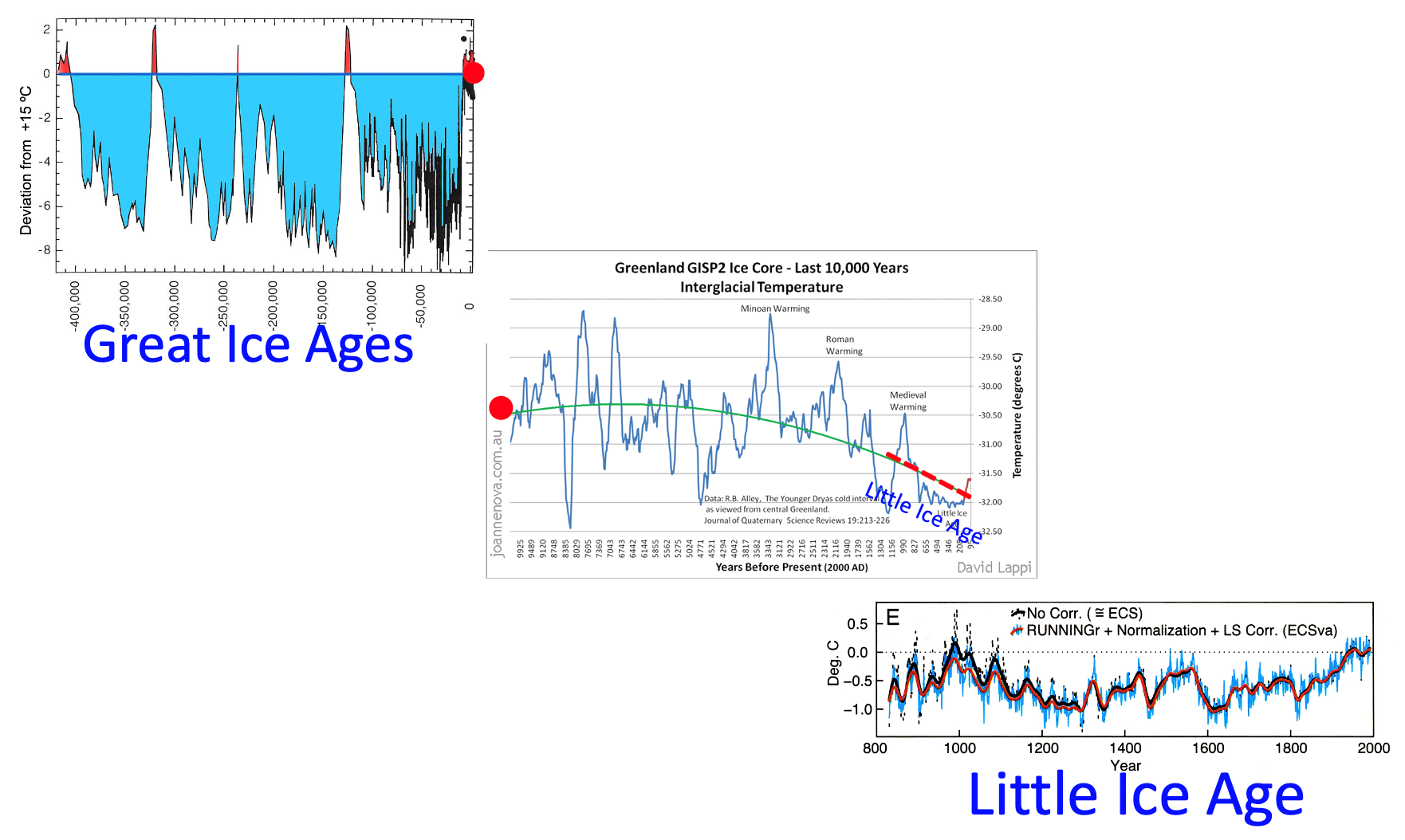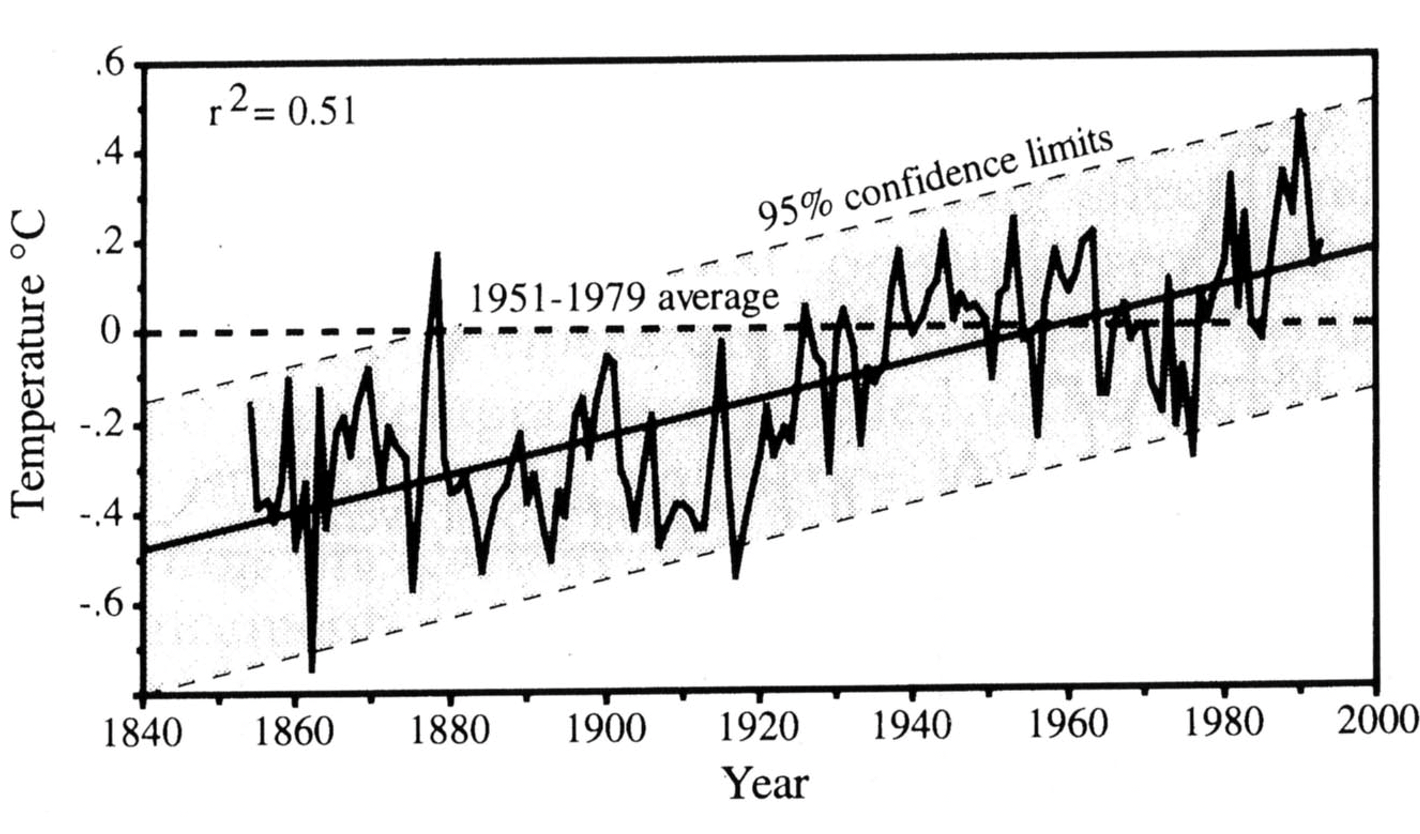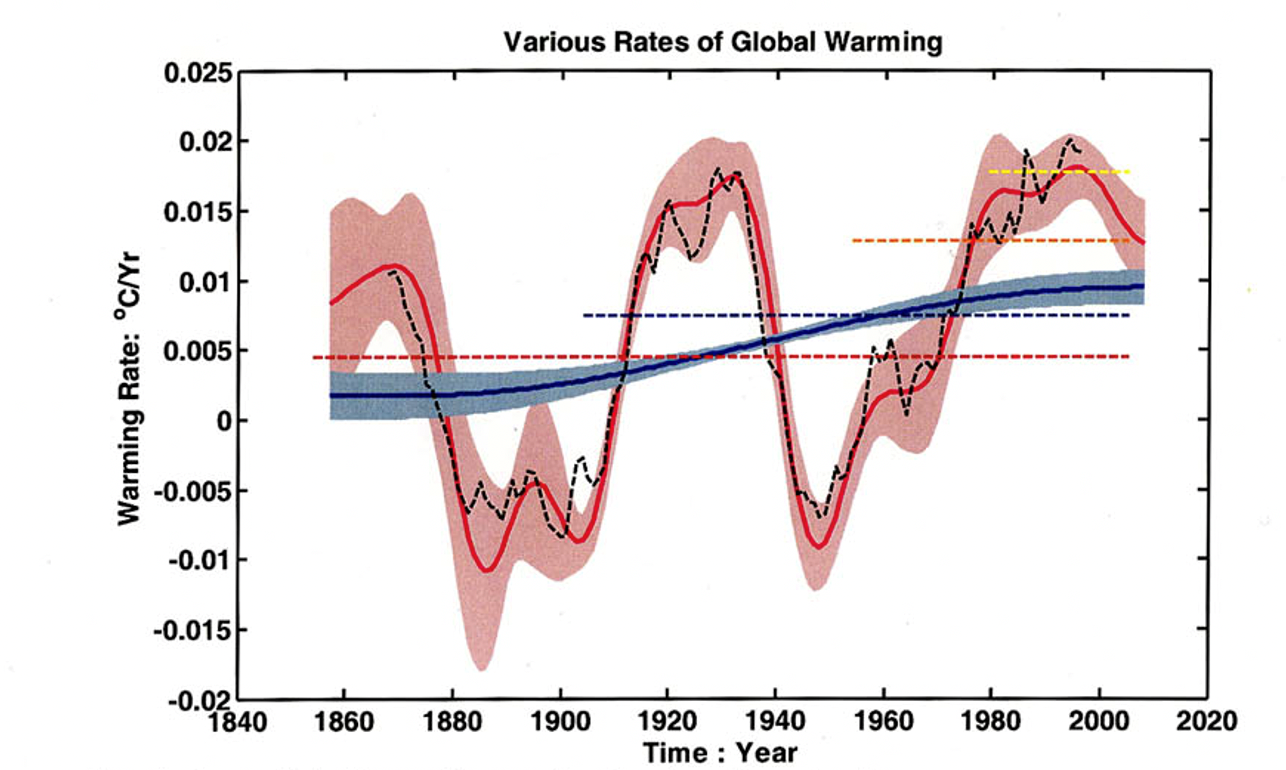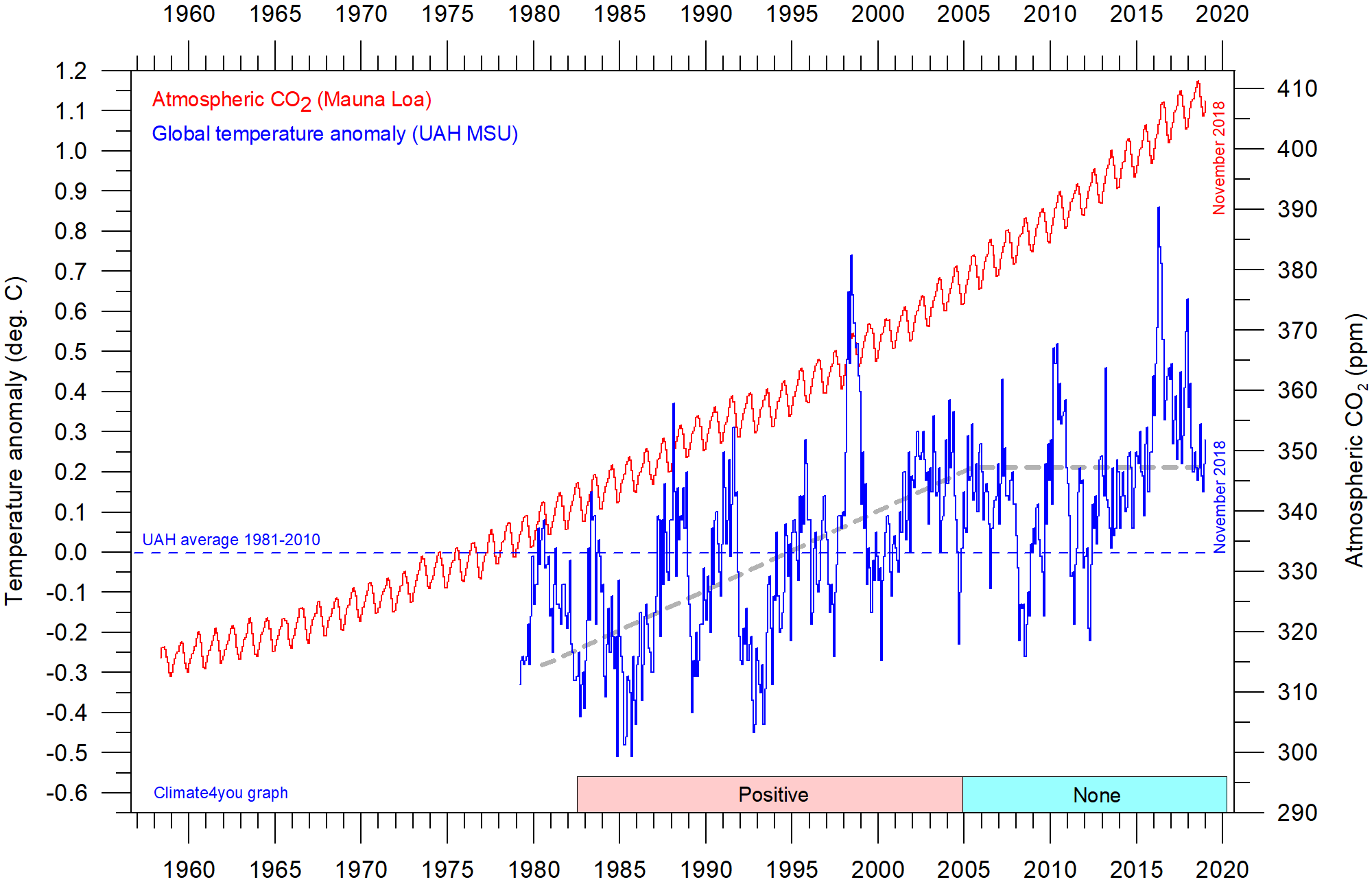eISSN: 2576-4543


Review Article Volume 5 Issue 2
1International Arctic Research Center, University of Alaska Fairbanks, USA
2Center for Computational Science, University of Tsukuba, Japan
Correspondence: Syun Ichi Akasofu, International Arctic Research Center, University of Alaska Fairbanks, USA, Tel 907-474-6012, Fax 907-474-5662
Received: August 14, 2021 | Published: August 27, 2021
Citation: Akasofu SI, Tanaka HL. On the importance of the natural components in climate change study: Temperature rise in the study of climate change. Phys Astron Int J. 2021;5(2):73-76. DOI: 10.15406/paij.2021.05.00236
The theme of this paper is to show that the temperature rising rate by the greenhouse gases is only 1/5 of what is generally considered. This conclusion is based on identifying two natural global changes. One of them is a near-linear change after the Little Ice Age (LIA) and the second is the Pacific (PDO) and Atlantic AMO) decadal oscillations, together called MDO. After the end of the LIA in about 1850, the rising rate of temperature rise has been approximately linear with the rate + 0.3°C/100 years, while the MDO has been super9 posed on it with an amplitude of 0.2°C (the range = 0.4ºC) and the period of 40-60 years. The combined rise of temperature by the two natural components between 1975 and 2000 (which is considered to be due to CO2 by the IPCC) is 0.47°C; it is comparable with the observed rise of 0.5°C during the same period. Thus, the contribution of the greenhouse gases for the same period is estimated to be at most 0.1°C, not 0.5°C.It is estimated that the temperature rise from 2000 to 2100 will be 0.9°C± 0.2°C (=‘recovery’ from LIA + greenhouse gases + MDO), namely 0.3°C + 0.4°C ± 0.2°C, namely between 0.7°C and 1.1°C, assuming that the present production rate of the greenhouse gases is maintained.
Keywords: natural components little ice age Pacific decadal oscillation Atlantic decadal oscillation greenhouse gases
Climate change recorded by the observed global temperature change consists of both natural component and man-made component (greenhouse gases, etc.). Thus, in order to estimate accurately the man-made component, it is necessary to identify and determine the natural component and subtract it from observed change. This process is crucial in identifying man-made component and thus in predicting future temperature by the greenhouse gases. At present, it is assumed that the observed increase of global temperature is considered to be mostly by the greenhouse gases without subtracting the natural component. Figure 1 shows global temperature changes from 1850 to 2010. The IPCC attributed the temperature rise during the last part of the last century, particularly from about 1975 to 2000, was due “very likely” to the warming by the greenhouse gases (IPCC 2007).This claim and the rate of increase have become the basis of predicting future temperatures by a large number of computer simulation studies since then. In Figure 1, it may be also noted that there was a similar rise from 1910 to 1940, but then a slight decrease until 1975. This has been no clear explanation for these changes; it is hard to explain them in terms of the increasing trend of the greenhouse gases, because a rapid increase of CO2 began in 1946.

Figure 1 Temperature variations between 1850 and 2010 (the IPCC). Note that the chosen baseline is not the average value during the period indicated.
Further, the baseline used in Figure 1 is chosen to emphasize the rapid rise of the temperature after 1975, not the average temperature during the period. In this paper, we propose that the rise of temperature between 1975 and 2000, as well as between 1910 and 1940, is mainly the combined result of two prominent natural components. The first one is a near-linear rise after the Little Ice Age (LIA) after 1850 as shown in Figure 2. It is discussed in Section 2. The second one is a semi-periodic natural component superposed on the near-liner component, which includes both the Pacific Decadal Oscillation (PDO) and the Atlantic Multi-Decadal Oscillation (AMO)1 the combined change is called MDO in short; see also Section 3 (p.11).

Figure 2 Temperature changes from about 400,000 years ago. The changes during 400,000 years is shown by shading blue below the baseline and above in red.13 The second is the Greenland GISP2 Ice Core Project record. The last one is the tree-ring record.17 Note that GISP2 record reproduces the tree-ring record, red dash line).
The two changes are discussed in Section 2 and Section 3, respectively. For these reasons, it is worthwhile to review temperature changes during the last 400,000 years, since practically all temperature changes before 1850 can be considered to be mostly natural change, although the Industrial Revolution began earlier. Figure 2 shows, from the top, temperature changes from 400,000 years ago (Muller and MacDonald, 2002). The temperature changes after the four Great Ice Ages (GIAs)are shown with two extended time scales, the data from Greenland GISP 2 Ice Core project and the tree-ring data. The GISP 2 record shows a gradual decrease of the temperature after the last GIA. The tree-ring record is clearly recorded in the last part of the GISP2 data (based on the O18 method).
From such an assembly of the past records, it is obvious that there are always natural changes in progress, so that the natural component is always present. However, unfortunately, their causes are not known, except the Milankovitch theory could partially explain the GIAs. Here, it is attempted here to identify two natural components, which are likely to be persisting at present and also possibly in future.
It is reasonably certain that the LIA was present and lasted for about 600 years on the basis of GISP2 and the tree-ring record in Figure 2. The LIA ended in about1850, and subsequently the temperature has begun to rise. In a recent paper,2 Gebbie and Huybers showed that the linear increase began in about 1850. The increase of the temperature after 1850 was further confirmed by other data sets.3
Tree ring- worldwide
Glacier- (Alaska, Greenland, Alps, New Zealand, Himalaya, Africa, South America),
Sea level- including the southern extent and satellite data,
Freezing and breakup – a number of rivers and lakes in the world,
Mg/Ca analysis (Gulf of Mexico),
Cherry blooming (Japan)
The causes of the LIA, the last long cooling period, are not conclusively known. However, there are various ideas on the causes of the LIA, such as changes of solar activities.4 Muscheler showed their solar modulation function based on cosmic ray changes (deduced from 14C and 16Be), including the period after the LIA. Figure 3 shows their result. This function has a similar variation to the temperature change deduced from the above tree ring record (Figure 2); on the LIA, see also a recent paper by Hannibal5 Some of the important characteristics of temperature changes during and after the LIA are:

Figure 4 The near linearity of temperature change between 1840 to 2000.16
Since it is reasonable to assume that the LIA is a natural phenomenon, the near-linear rise between 1850 and 1946 can tentatively be considered to be the ‘recovery’ from the LIA. Further, there is no specific reason to assume that the near-linear change has ended in 2000, so that it is reasonable to infer that it continues to the present and even after 2000.Thus, it is important to subtract the amount 0.3ºC/100 years in estimating effects of the greenhouse effects in the future.
Superposed on the near-liner rise discussed in Section 2, there are semi-periodic changes. The MDO are likely to be natural changes, because the greenhouse gases are not likely to show a periodic change. Thus, they must be subtracted from the observed temperature change in the past in estimate effects of the greenhouse gases. In fact, as we discuss in the following, it is likely to be the main cause of the hiatus. Figure 5 shows the spectral analysis of the changes by Wu Z.6 Wu Z6 showed that the amplitude associated with the MDO is roughly 0.2°C and the period is about 40-60 years; note that since other semi-periodic changes are also present, these values are only approximate ones. Based on their studies, the contribution of the MDO between 1975 and 2000 is approximately 0.4°C; note that the MDO peaked in 2000, a minimum in about 1950, in the data used by Wu Z6 and a maximum in about 2000. The result by Wu Z6 confirms that the rise between 1950 and 2000, as well as between 1910 and 1940, is a semi-periodic change. Thus, the temperature increase between 1975 and 2000 was not particularly abnormal, although the IPCC claimed the rise is “very likely” due to the greenhouse gases; particularly because there was a similar increase between 1910 1nd 1940. 7Mantua and Hare mentioned that PDO can be traced back to 1600 (tree-rind and coral), the mechanism causing it is not clear, and the cause of its variability (the periodicity 15-25 and 50-70 years) is controversial. The structure of PDO may be characterized by a wedge shape of warm SST anomaly along the equator over the eastern Pacific associated with the cold SST anomaly in mid latitudes surrounding the wedge shape. The anomaly is similar to the La-Nino pattern, but the timescale is much longer, showing a multi-decadal oscillation. The PDO index was positive for the period between 1925 and 1945 and also between 1975 and 2000, and negative between 1945 and 1975 and also between 2000 and 2014. The index was positive for the period between 2014 and 2019 after the strong El-Nino in 2015, but it returned to negative in 2020.The atmospheric response to PDO is similar to El-Nino in that the global scale warming (cooling) occurs for the positive (negative) index.

Figure 5 The spectral analysis of temperature changes between 1860 to 2010 by Wu.6 Both the near-linear change and the periodic changes can be recognized.
In contrast, the structure of AMO may be characterized by the mean SST anomaly over the North Atlantic. The AMO index was positive for the period between 1930 and 1960, and also between 2000 and 2020, and negative for the period between 1890 and 1930 and also1960 and 2000. The timescale of AMO is apparently longer than that of PDO, showing the period of 60 to 70 years. Both PDO and AMO are the key factors of climate change of the multi-decadal oscillation (MDO). Since the MDO plays a very important role in climate change, it is worthwhile to examine its variability. Specifically, it is shown that the variability of MDO can be quantitatively explained by changes of planetary albedo.8 Tanaka and Tamura examined the variability of MDO, using JRA-55 reanalysis data by Japan Meteorological Agency. They found that the time change of the mean planetary albedo in the Northern Hemisphere during 1958 to 2012 is in phase with MDO. The albedo is ranging from the minimum of 0.319 W/m2 to maximum of 0.326 W/m2. The range of variation is about 1% of the mean value of the planetary albedo. The 1% variation of planetary albedo represents 4 W/m2 of radiative forcing owing to the strong mean solar radiation of 341 W/m2. Further, since the long-term variability of planetary albedo may be sensitive to the data assimilation method, they repeated the same analysis using ERA-Interim and found the same multi-decadal variability. The time change of planetary albedo was also compared with the satellite observations by Palle.9 Thus, the result is interesting in that the change in planetary albedo can be one of the possible causes of the multi-decadal variability in global mean temperature, and thus the variability caused by planetary albedo can also be considered as a proof of natural change. Their result is shown in Figure 6. It can be seen that about a half of the rapid warming trend during 1975 to 2000 can be explained by the albedo change (natural variability).

Figure 6 Multi-decadal variability of Northern Hemisphere mean temperature (blue) owing to the albedo change, superimposed on the linear trend expected by the recovery from the LIA during 1900 to 2020 (red). Arrows after 1958 show radiative forcing by albedo change.8
In spite of various uncertainties in the above analyses, what is crucial here is that the combined temperature rise by the near-linear trend (0.07°) and the MDO (0.4°C, namely the range [amplitude 0.2°Cx 2]) between 1975 and 2000 is comparable with the observed temperature rise (0.5°C) between the same period. Therefore, within the accuracy of observations and analysis, it may be stated that the temperature rise caused by the greenhouse gases is much smaller compared with the combined rise caused by the two natural changes between 1975 and 2000, about 0.1°C, instead of 0.5°C. The above conclusion can be tested with the records in Figure 7, which shows the recent satellite temperature data up to 2018 (UAH and MSU; Humlum,10 together with the CO2 data from Mauna Loa. It can be seen that the rate of the observed temperature rise (0.5°C/25 years) between 1975 and 2000 has not been continued (see the dash line), in spite of the fact that the amount of CO2 is still rising rapidly. The rise of the temperature between 2000 to 2018 is at most 0.1°C as inferred in the previous section. We can show also here that the effects of the greenhouse gases are only one fifth of the IPCC assumption on the basis of the observed CO2. Based on Figure 7, it can be estimated that the rate of temperature rise by the greenhouse gases between 1975 and 2000 is a little more than 0.2°C/ 100 ppm, instead of 1.0°C/ 100 ppm by assuming that the temperature rise is caused by the greenhouse gases. On the other hand, the TRAC model based on Had CRUT4 model uses the rate equivalent to 0.5°C/100 ppm.11 Therefore, the rate of temperature rise by the greenhouse gases is overestimated in the past. Figure 8 shows clearly this fact12 many simulation studies predict, on the average.13 The temperature increase by 0.4°C (many of them even much higher than 1.2 °C) between 2000 and 2020, instead of the observed 0.1°C or so.

Figure 7 Global air temperature (UAH, MSU) and the atmospheric CO2 (Mauna Loa).10 note that two sharp increases of the temperature in about 1997-1998 and around 2016-2017 are known as the El Nino effect (natural change).

Figure 8 A comparison of a number of simulation results and observed changes.12
Based on reviewing the earlier studies by others and our own results, it is shown that the natural components, the MDO and the rise after the LIA,13 contribute significantly to climate global temperature.15,16 If this trend would continue until 2100, the temperature17 rise from 2000 to 2100 will be at most 0.9°C (= ‘recovery’ from LIA + greenhouse gases + MDO), 0.3°C + 0.4°C ± 0.2°, namely between 0.7°C and 1.1°, including the effects of the greenhouse gases by assuming that the present increasing rate of the greenhouses gases is maintained. Although the causes of the two natural changes are not known, and thus they cannot be programed in simulation studies, their presence should not be ignored. At least,18 Their possible effects in the future should be mentioned in predicting the temperature in 2100, because both could be present in 2100. The near-halting or the hiatus is expected from our study in the earlier sections, because the MDO is entering to the declining phase after peaking in 2000. Further, there was an earlier hiatus between 1940 and 1975 (Figure 2), indicating also the importance of the MDO.
None.
The author declares there is no conflict of interest.

©2021 Akasofu, et al. This is an open access article distributed under the terms of the, which permits unrestricted use, distribution, and build upon your work non-commercially.